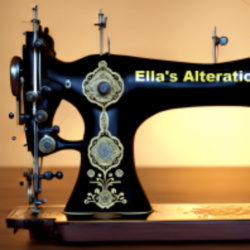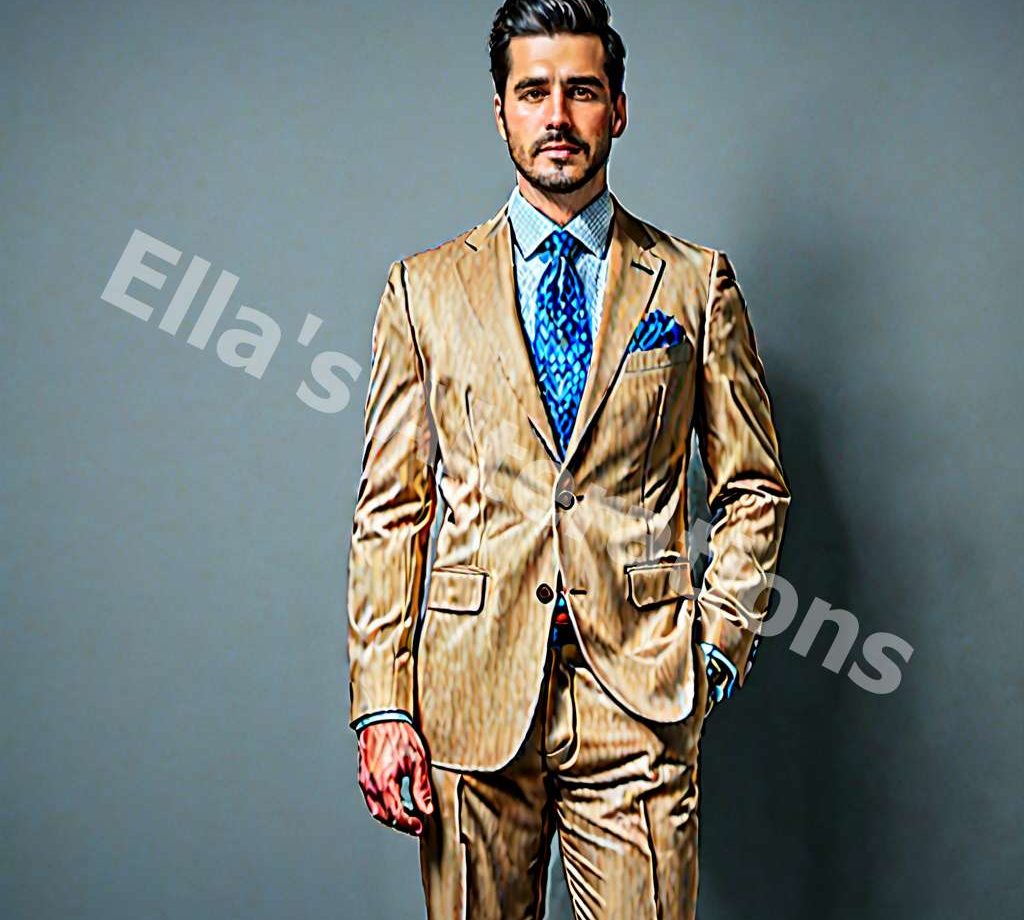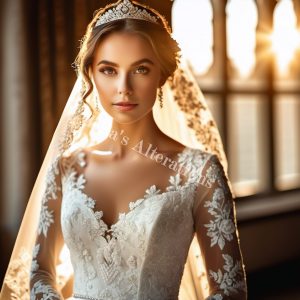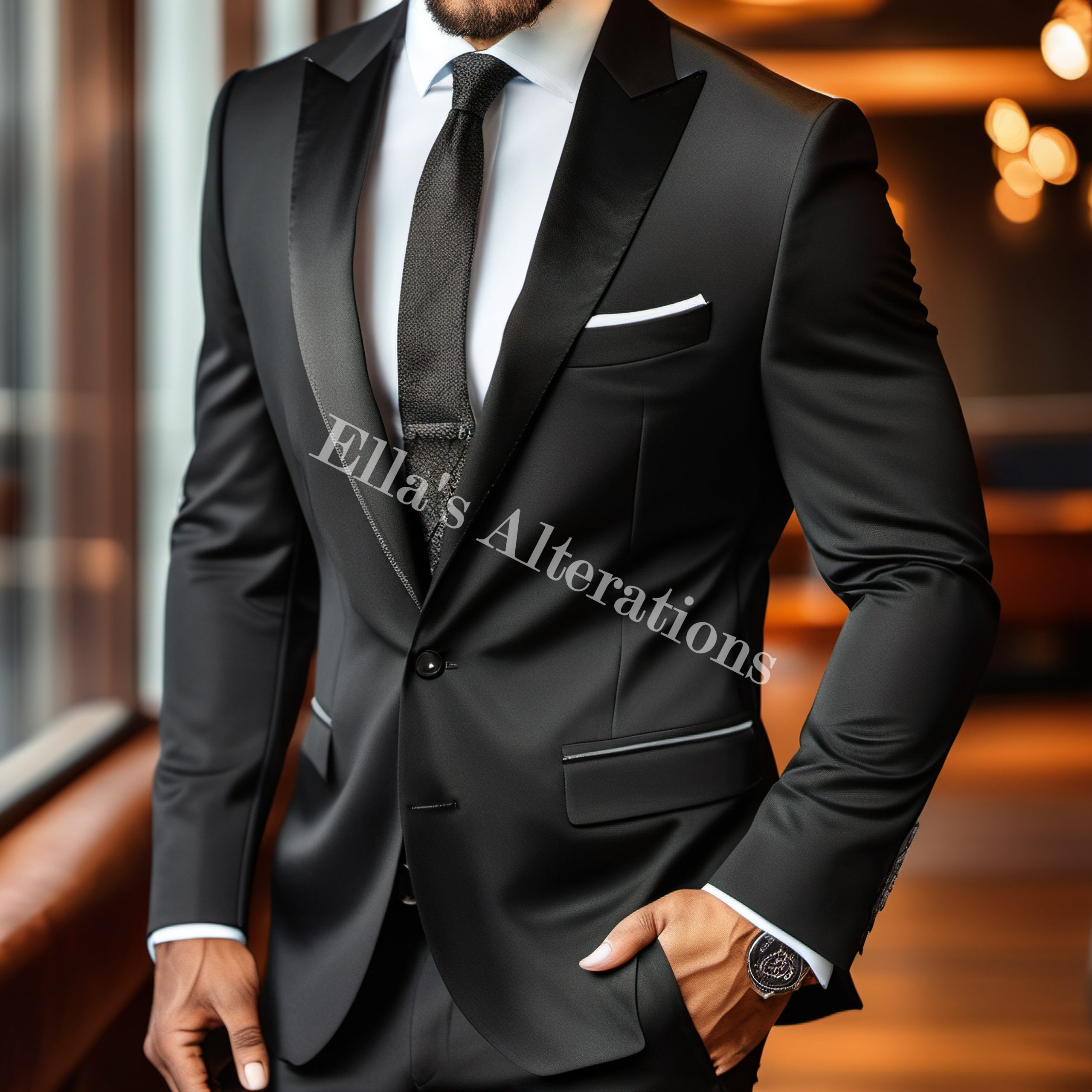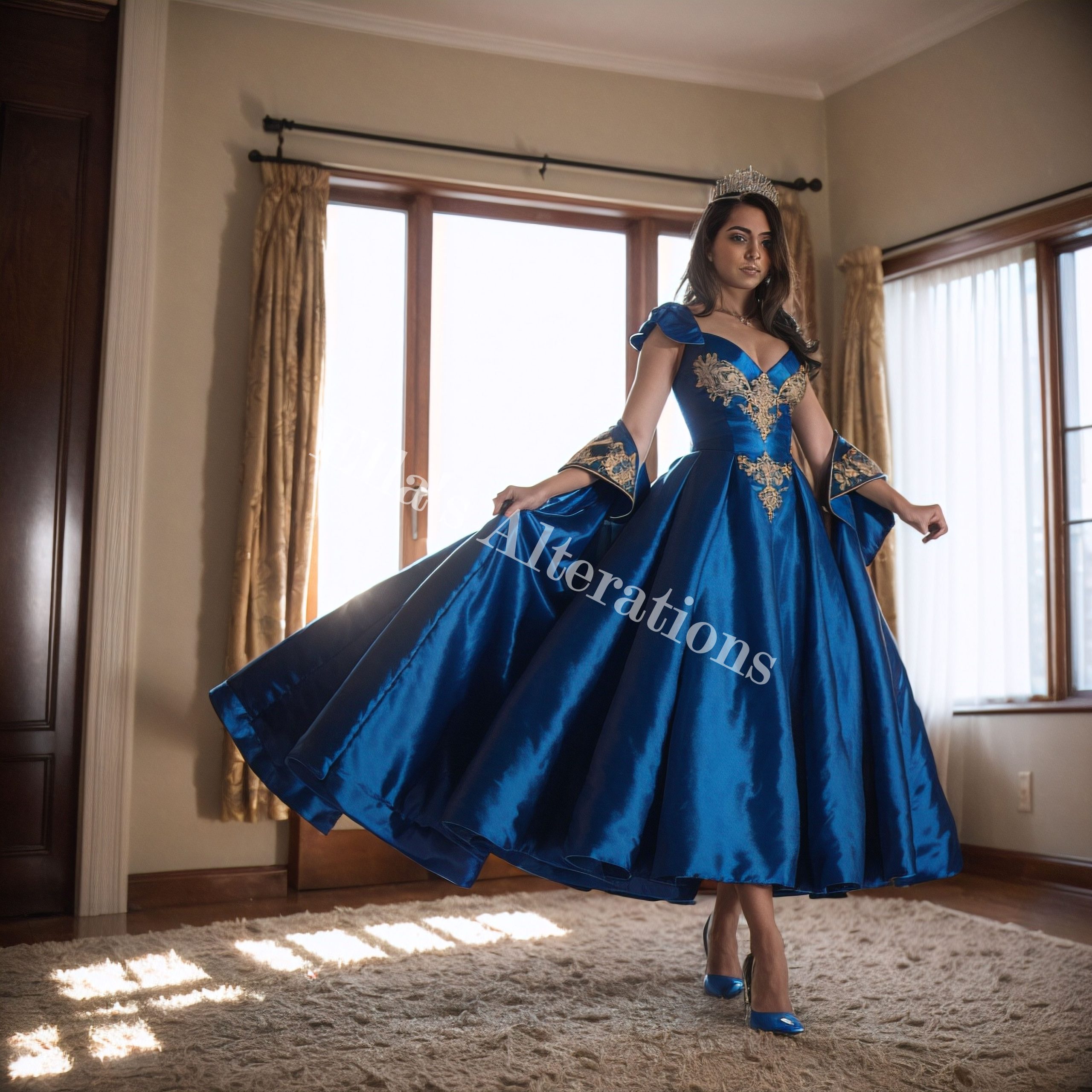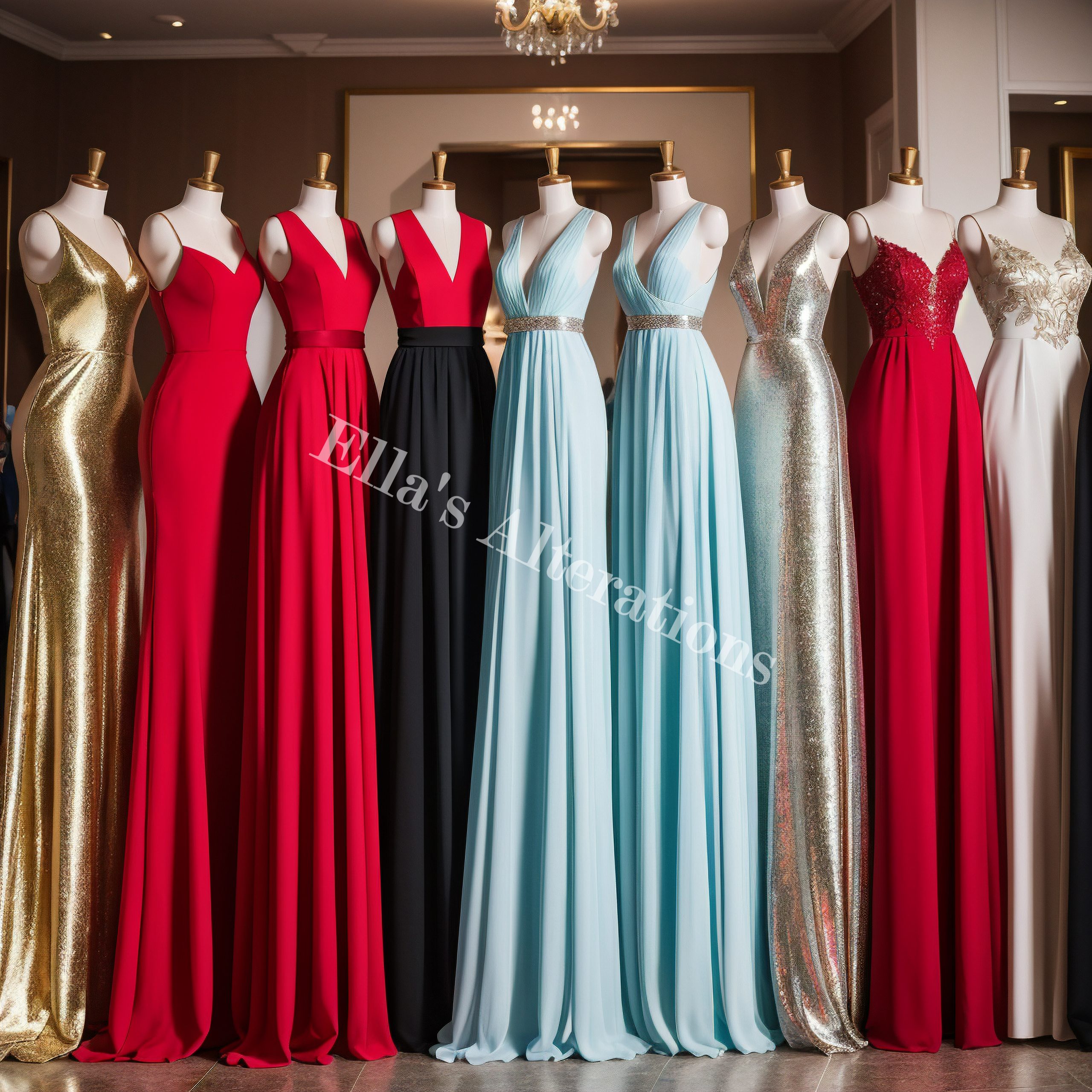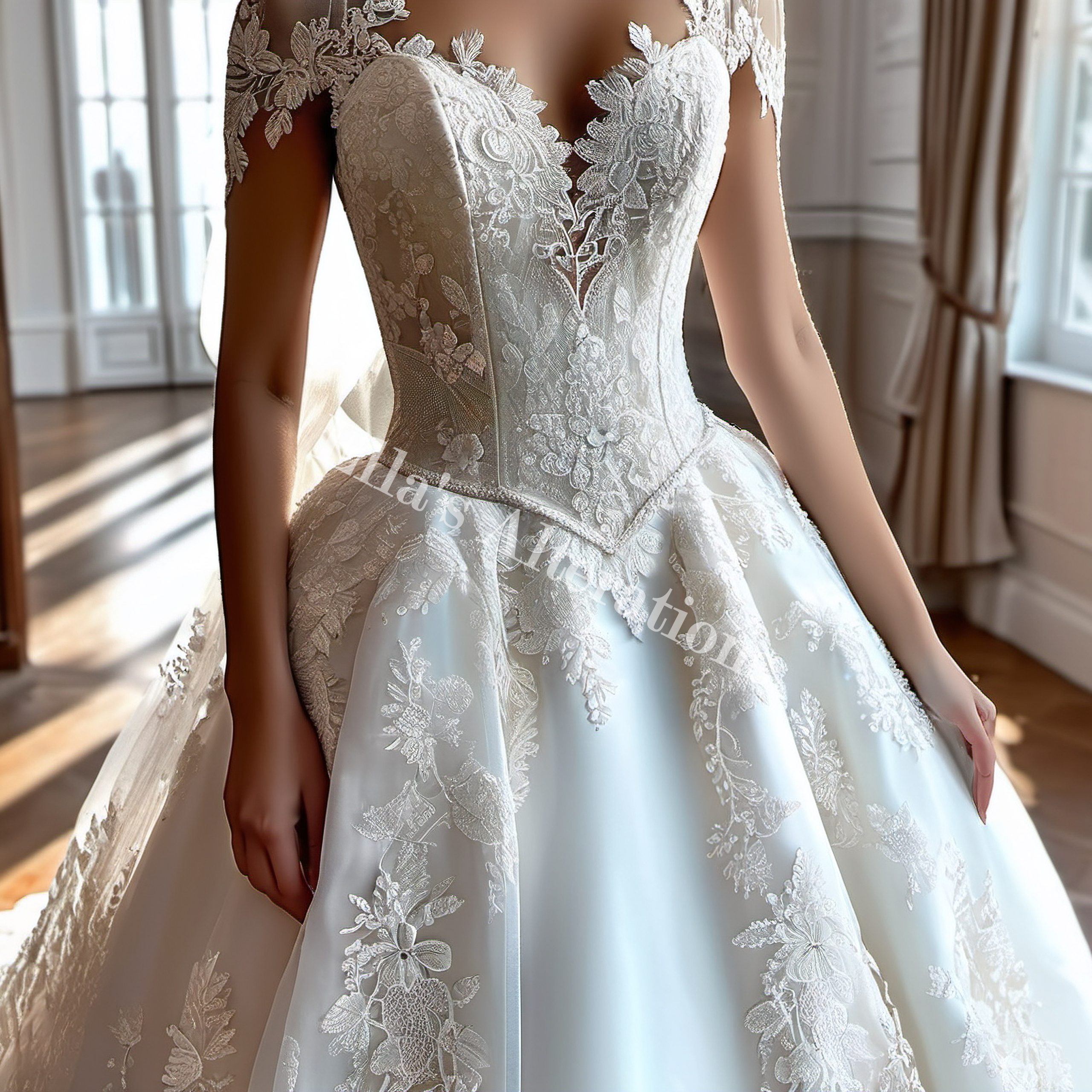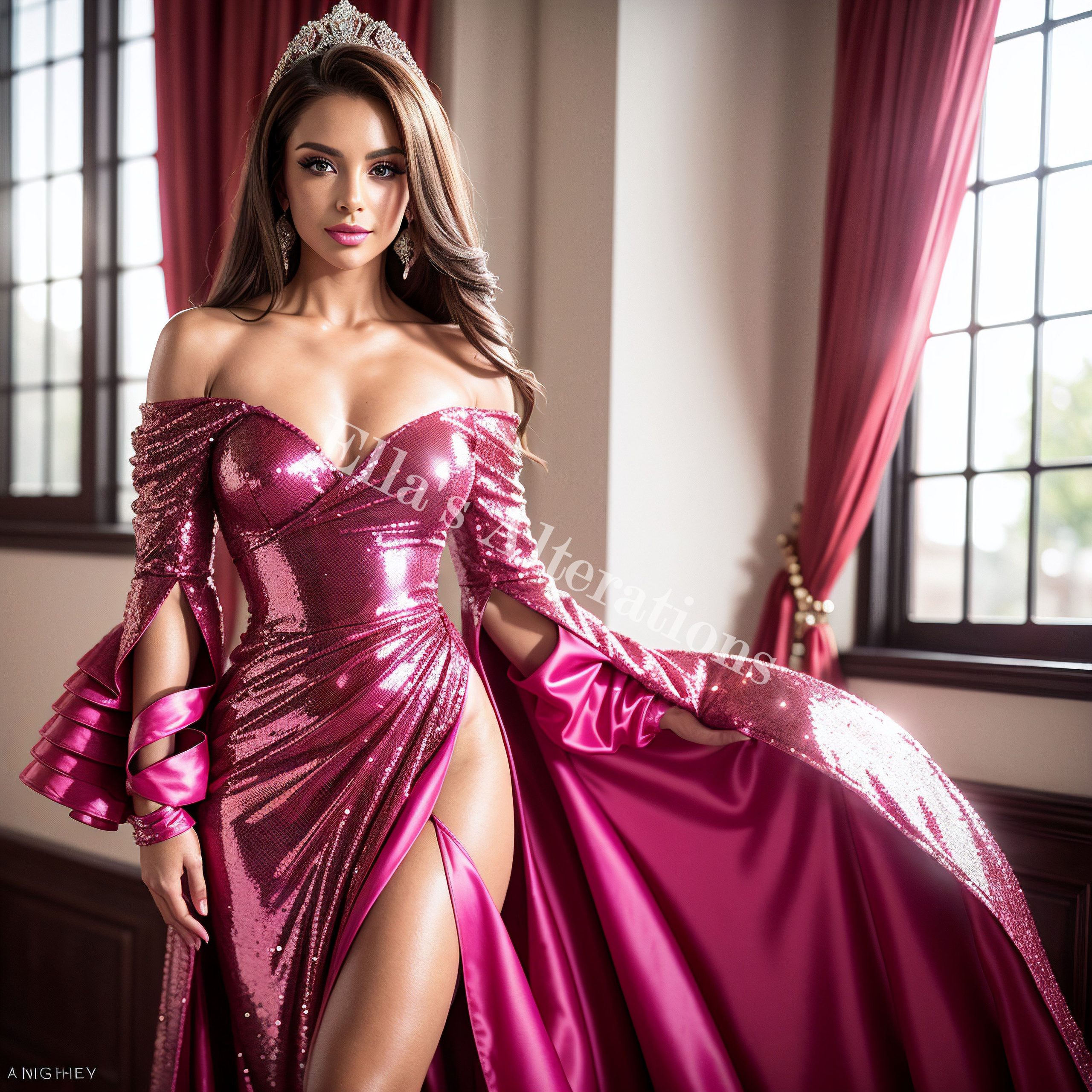Introduction:
When it comes to crafting the quintessential men’s suit, the distinction between a tailor and a seamstress becomes prominently clear.
Tailors, with their specialized skills in suit construction and fitting, are often seen as the guardians of sartorial elegance.
They wield the tools of their trade—fabric, thread, and needle—with a level of precision that transforms simple cloth into a statement of personal style and professionalism.
The tailor’s craft extends far beyond the basic act of sewing.
It involves a deep understanding of textiles, the dynamics of human anatomy, and the aesthetics of style—all of which are critical when crafting men’s apparel that fits flawlessly and flatters the wearer.
This is not merely a job; it is an art form where each stitch and cut is a deliberate and calculated decision to enhance the garment’s fit and function.
Contrastingly, seamstresses are traditionally skilled in general sewing and repairs, often working across a variety of garments including women’s clothing, curtains, and linens.
While seamstresses are undeniably talented and crucial in the broader fabric and fashion industry, their expertise does not typically focus on the specific needs of men’s suiting.
The precision required in a bespoke suit—a garment that can define the tone of significant life events like weddings or major business dealings—demands a tailor’s unique set of skills.
In the realm of high-stakes fashion where every detail counts, the tailor’s ability to sculpt fabric to a man’s body using a combination of artistic vision and technical prowess is paramount.
This skill set ensures not just a garment that fits, but a garment that performs—enhancing the wearer’s figure, instilling confidence, and standing up to the scrutiny of high-profile engagements.
Also, the historical evolution of tailoring reveals its roots in exclusively crafting men’s apparel, which has allowed tailors to refine their art over centuries.
From the regal courts of Europe to the bustling modern cities of today, tailors have shaped the perceptions of menswear.
This rich history brings with it a depth of knowledge and tradition that is irreplaceable in the world of men’s suits.
Ultimately, selecting a tailor over a seamstress for suit-making is not about gender or capability but about choosing the right artisan with the right expertise.
A tailor’s focused experience in men’s fashion is what makes them indispensable for anyone looking to invest in a suit that truly fits like a second skin, crafted not only to meet the wearer’s physical measurements but also their lifestyle needs and aesthetic desires.
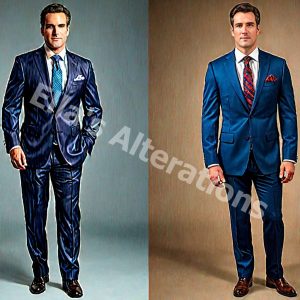
The Art of Tailoring vs. Seamstress Skills:
Delving deeper into the world of custom garments, the distinction between the art of tailoring and the skills of a seamstress is marked by the specialized knowledge and techniques required for men’s suit tailoring.
Tailoring is an age-old profession that not only demands a precise set of skills but also an in-depth understanding of the intricacies of menswear.
Tailors are trained specifically to work with the structure and styling of suits, which involves a complex understanding of how different fabrics will conform and react to the human body.
The process begins with meticulous measurements that are often taken over multiple fittings to ensure the suit complements the wearer’s body in every conceivable way.
This can include adjusting the shoulder area for a perfect seam alignment, shaping the waist to enhance or minimize the torso appearance, and altering the length of trousers and sleeves for a sharp, clean line.
Furthermore, tailors are adept at manipulating heavier and more complex materials commonly used in men’s suits such as wool, tweed, and cashmere.
They use specialized techniques such as canvassing—a method of constructing suits that provides a better drape and durability— which are rarely required in the typical tasks handled by a seamstress.
Their skills are indispensable in general garment repair, modifications, and adjustments.
They work with a wide array of materials and are versatile in their craft, handling everything from delicate silks used in women’s wear to sturdy cottons used in everyday clothing.
However, the precise demands of fine suit tailoring—particularly the construction of a garment that must fit like a glove while allowing for mobility and comfort—are not typically within the extent of a seamstress’s day-to-day operations.
Additionally, tailors also bring an element of artistic creativity to their work, designing pieces that not only fit well but also align with current fashion trends and individual style preferences.
This involves a deep engagement with the client, understanding their needs, lifestyle, and personal style.
Tailors consider factors such as the occasion for the suit, the wearer’s professional environment, and even climatic conditions which might influence the choice of fabric.
While the roles of tailors and seamstresses might overlap in the broad category of garment construction, the specialized nature of a tailor’s work makes them particularly essential for constructing men’s suits.
Their focused expertise in menswear, coupled with a strong tradition of bespoke tailoring, enables them to create garments that are not just worn, but are celebrated as a symbol of personal elegance and professionalism.
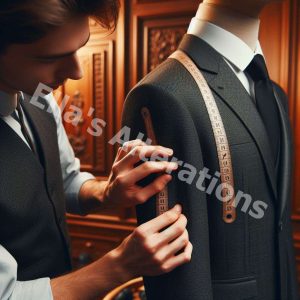
Understanding Suit Alterations and Tailoring:
The realm of suit alterations and tailoring is both intricate and critical, primarily when focusing on the specialized adjustments that a tailor can masterfully execute to elevate a suit from merely good to absolutely perfect.
The understanding and implementation of these alterations are what distinguish a tailor’s expertise from the broader skill set of a seamstress.
Suit tailoring begins with a deep analysis of the suit’s fit on the client’s body.
This isn’t just about where the fabric sits; it’s about checking out how the suit moves and fits when you’re walking around or striking a pose.
It’s like making sure the suit isn’t just hanging there but actually feels right and looks good when you’re on the go.
Tailors adjust various elements of a suit such as the jacket shoulders, sleeve length, waist suppression, and trouser break and taper.
Each of these adjustments requires precision and an understanding of complex construction techniques that are specific to menswear.
For instance, adjusting the shoulders of a suit jacket, often considered one of the most challenging areas to alter, requires not just resizing but reshaping the entire structure to maintain an elegant and natural line.
This is something that goes beyond the capabilities of typical seamstress work, which might include simpler, more straightforward tasks such as hemming trousers or adjusting a waistband.
Additionally, tailors often undertake what is known as ‘recutting’—a more drastic form of alteration that involves deconstructing the suit to fundamentally change its size and shape.
This could be necessary when a client has experienced significant changes in body shape, or when a suit needs to be updated to reflect more contemporary styles.
Doing this much tweaking needs some serious skills and know-how about how fabrics work and design stuff.
It’s not usually the kind of thing a regular seamstress would handle.
It’s like asking a painter to fix your car – they might know their colors, but they’re not the best choice for getting under the hood.
Furthermore, the aesthetic aspects of suit tailoring cannot be overstated.
Tailors work not only to achieve a perfect fit but also to ensure that the suit’s alterations enhance the wearer’s best features, adhering to both symmetry and proportion.
This bespoke approach ensures that the suit looks tailor-made, crafted uniquely for the individual, rather than adjusted.
*”Bespoke” basically means something that’s custom-made or tailored specifically for someone.
In addition to technical skills, effective communication between the tailor and the client is essential in suit tailoring.
Tailors must understand and interpret the client’s needs and preferences, often advising on style choices based on the occasion for the suit, the client’s personal style, and even future wear considerations.
Working together like this helps us get a final product that’s not just better in how it works, but also feels just right for the client.
The detailed and specialized nature of suit alterations and tailoring confirms why tailors are indispensable when it comes to men’s suits.
Their comprehensive skill set, combined with a focus on precision and customization, ensures that each suit is not just a piece of clothing, but a reflection of personal style and distinction.
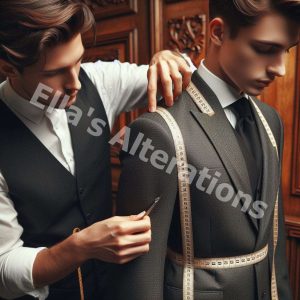
How to Choose a Tailor for Your Needs: Men and Women!
The Suit Fitting Experience:
The suit fitting experience is a quintessential element of the tailoring process, embodying a blend of tradition, precision, and personalized service that defines the artistry of a master tailor.
This meticulous process is where the tailor’s expertise truly shines, distinguishing their role from that of a seamstress in the realm of men’s formal wear.
A suit fitting typically begins with a consultation, where the tailor assesses the client’s needs, preferences, and the intended purpose of the suit.
This initial chat sets the stage for a bespoke creation that is tailored not only to fit the body but also to suit the wearer’s lifestyle and aesthetic preferences.
During this phase, the tailor will discuss fabric choices, styles, and the finer details such as lapel width, pocket style, and button configuration, which are essential for crafting a garment that reflects the wearer’s individuality.
Following the consultation, the tailor takes precise measurements, noting not only the size but also the posture and body nuances of the client.
These measurements aren’t just about numbers; they’re about catching all the curves and angles of your body so the suit moves with you, feels comfy, and still looks sharp.
This detailed understanding of anatomy is critical, as it influences how the tailor will cut and construct the suit.
The next step involves a series of fittings, where the tailor presents a basted suit—a loosely stitched garment that allows for major adjustments before the final sewing.
This is a crucial stage, as it provides both the tailor and the client with the opportunity to refine the fit and make necessary alterations.
The basted fitting* is where the sleeves, collar, lapels, and overall drape are adjusted to perfection.
A “basted fitting” is a temporary fitting in the process of making a garment, where the pieces are loosely sewn together to allow adjustments before the final sewing.
It’s like a rough draft of the garment to make sure everything fits before making it permanent.
We might go back and forth a few times, making tweaks along the way, showing how dedicated the tailor is to getting everything just right.
During these fittings, the tailor’s skill in adjusting and reshaping the garment becomes evident.
It is here that they perform the fine tuning that defines the silhouette and ensures the suit complements the wearer’s physique perfectly.
The tailor might adjust the taper of the trousers, the snugness of the jacket at the waist, or the hang of the jacket to correct any imbalances or asymmetries.
Ultimately, the final fitting is where the client sees the culmination of the tailor’s craft—a suit that fits impeccably and enhances the wearer’s best features.
This final reveal is often a moment of true transformation, where the client can fully appreciate the difference that a professionally tailored suit makes, not just in appearance but in confidence and comfort.
The suit fitting experience offered by a tailor is an elaborate, highly personalized service that transcends mere clothing adjustment.
It’s like diving into a cool adventure that honors the tradition of custom tailoring but also ends up giving you a piece of clothing that’s practically a work of art.

The Bespoke Suit Advantage:
Choosing a bespoke suit crafted by a skilled tailor offers a series of unparalleled advantages that ready-made or off-the-rack suits simply cannot match.
This segment of tailoring is where the tailor’s expertise, creativity, and attention to detail come into full play, providing the wearer with not just a suit, but a hallmark of personal style and refinement.
The primary benefit of opting for a bespoke suit is the assurance of a perfect fit.
Unlike off-the-rack options that are made to fit standard sizes, a bespoke suit is constructed from scratch based on the client’s precise measurements.
This custom fit addresses not only the width and length but also subtler aspects like posture and body asymmetries.
Tailors pay attention to every little detail of how you’re built, so the suit looks awesome on you without having to make any sacrifices.
Furthermore, bespoke tailoring allows for complete customization.
Clients have the freedom to select every element of the suit from a wide range of high-quality fabrics, linings, buttons, and thread colors.
This level of customization extends to the style and cut of the suit, enabling the wearer to specify their preferred lapel style, vent placement, pocket configuration, and even monogramming details.
This personal touch is what sets bespoke suits apart, making each piece a unique expression of the wearer’s taste and personality.
The process of creating a bespoke suit also involves a high degree of craftsmanship.
Tailors use old-school methods that have been perfected over hundreds of years, sometimes adding hand-sewn bits for extra strength and fancy vibes.
All this careful crafting not only makes the suit look great but also makes it last longer, so it’s a smart choice for your closet in the long run.
On top of that, the bespoke route offers a timeless quality.
Because each suit is individually tailored, it can avoid the whims of fast fashion and transient trends.
The result is a classic garment that remains stylish and relevant over many years, often outliving many cycles of ready-made fashion.
This enduring quality not only makes bespoke suits environmentally sustainable but also cost-effective over the long term.
Lastly, the bespoke suit tailoring process itself is an experience to be cherished.
The relationship that develops between the tailor and the client during this process is built on trust and mutual respect.
Tailors often become style advisors, understanding their clients’ needs and preferences to a degree that allows them to make recommendations that clients might not have considered themselves.
The advantages of a bespoke suit go beyond the superior fit and customization options; they extend into a deeper realm of personal expression, quality, and lasting style.
Going for a custom suit is like saying “yes” to yourself, making sure every part of it fits just right and matches how you live and what you want to look like.
That’s why a bespoke suit is still the top pick for anyone who wants to really stand out with their style.
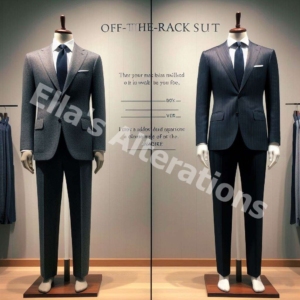
Stitch it Right: Understanding the Difference Between a Tailor and Seamstress.
The Costs and Benefits:
Figuring out the money side of custom tailoring shows how getting a tailor for men’s suits makes more sense than going to a seamstress.
It’s important to think about this to see why splurging on a tailored suit, even if it costs more at first, pays off in the end.
Firstly, the initial cost of a bespoke suit may be higher than purchasing an off-the-rack suit or opting for simple alterations from a seamstress.
This price difference stems from the labor-intensive process of creating a suit from scratch, the high-quality materials used, and the tailor’s specialized skills.
Each bespoke suit involves hours of manual labor, from the detailed measurements and pattern making to the meticulous cutting, sewing, and fitting sessions.
However, the benefits of investing in such craftsmanship are manifold.
A custom-made suit, or bespoke suit gives you top-notch quality and a fit that’s hard to beat.
Tailors use top-of-the-line methods like full canvas construction, so the suit hangs just right and gets even comfier the more you wear it.
This kind of construction also makes sure the suit stays strong and keeps its shape, so you can rock it for years to come without worrying.
The tailored fit not only improves how the suit looks but also how it feels.
A well-fitting suit moves with the wearer, reducing wear and tear on the fabric and seams, which commonly occurs in poorly fitting garments.
This extended lifespan of the garment makes bespoke tailoring a cost-effective choice in the long term.
Plus, a tailor can tweak the suit as needed as your body changes over time, keeping it useful and stylish for longer.
Beyond the tangible qualities, there are intangible benefits to consider.
A bespoke suit boosts the wearer’s confidence and professional image.
In lots of situations, how you look can really shape people’s first thoughts about you and the chances you get.
Sporting a suit that fits just right and looks spotless tells others you’re pro and you’ve got an eye for the little things, qualities that usually go hand in hand with being successful and dependable.
Plus, going for custom tailoring backs up artisan craftsmanship and helps cut down on environmental harm compared to the fast fashion cycle of buying and tossing ill-fitting, mass-produced clothes.
Each suit is crafted to order, which means less waste and a more eco-friendly approach to fashion.
While a custom suit might cost more upfront, the perks—like a perfect fit, top-notch quality, long-lasting wear, and timeless style—totally make it worth it.
Getting a tailored suit isn’t just a buy, it’s an investment in your closet, your professional image, and your personal style.
So, the money you put in isn’t just smart, it’s savvy.

Finding the Right Tailor:
Picking the perfect tailor is a crucial move for anyone thinking about splurging on a custom suit.
Who you go with can really make or break how happy you are with the finished product.
So, take your time and think carefully when making this choice. It’s worth it.
To start, research is key. Look for tailors with an established reputation in the field of men’s bespoke tailoring.
Many tailors will have reviews and testimonials from previous clients that can provide insight into their craftsmanship and service quality.
Online forums, fashion blogs, and even local directories can offer valuable information about the experience and expertise of potential tailors.
Once you’ve got a lineup of possible tailors, the next move is to swing by their shops in person.
This visit can tell you a lot about how much the tailor cares about the little things and how they treat their customers.
Check out how tidy the workspace is, how everything’s organized, and even how the staff acts.
A shop that’s well-kept usually means they’re serious about doing things right and giving you top-notch service.
During the visit, engage with the tailor directly.
A top-notch tailor will want to know all about your style vibes, what you’ll be using the suit for, and any special requests you’ve got.
They’ll chat with you about fabric choices, what’s hot in style, and might even show off some of their past projects.
It’s also crucial to ask about the tailor’s process.
Inquire about the number of fittings required, the turnaround time for a suit, and the types of fabrics available.
You might find that some tailors have a bunch of fancy fabric choices from top-notch mills, while others might have a smaller selection to pick from.
Understanding these details upfront can help set realistic expectations and ensure that the final product will align with your vision.
Another big deal is how willing the tailor is to chat and tweak things.
A solid tailor should be cool with hearing your thoughts and making changes as needed while you’re trying stuff on.
Being able to chat easily with your tailor makes the whole process smoother and means any issues can get sorted out right away.
Finally, consider the pricing and ensure it aligns with your budget.
While bespoke suits are an investment, the cost should still be transparent and justifiable.
A trustworthy tailor will be upfront about their pricing structure and provide a detailed breakdown of costs.
Finding the right tailor involves a mix of thorough research, personal interaction, and attention to detail.
By taking the time to select a tailor who not only has the technical skills but also a clear understanding of your personal style and needs, you ensure that your investment in a bespoke suit is both satisfying and worthwhile.
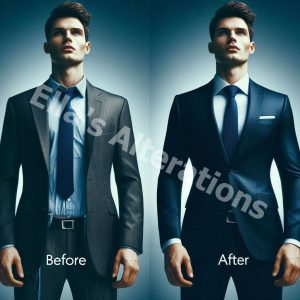
Conclusion:
Deciding between a tailor and a seamstress for making men’s suits boils down to knowing what each one brings to the party.
Tailors bring their special know-how and long history of making custom men’s clothes, giving you service and customizing that goes way beyond just basic fixes like seamstresses usually do.
This difference shows just how crucial tailors are in making suits that aren’t just snug but also show off your style and pro vibe.
Tailoring is more than just sewing pieces of fabric together; it is a comprehensive craft that involves precision, artistry, and a detailed understanding of human anatomy.
When a tailor gets to work on a suit, they dive into every detail, taking precise measurements and making custom tweaks to fit the wearer just right.
This personalized process means the suit ends up fitting like a dream, feeling comfy, and sticking around longer thanks to top-notch craftsmanship and materials.
Plus, the bond that forms between a tailor and their client is all about trust and talking things through.
They really get each other’s style and needs, which means the final product doesn’t just meet expectations but totally blows them away.
It’s a suit that boosts confidence, flatters the figure, and makes a splash wherever you go, be it at work or out on the town.
The investment in a bespoke suit also speaks to a broader commitment to quality over quantity.
In an era dominated by fast fashion, choosing a tailor-made suit is a choice to prioritize sustainability and craftsmanship.
This not only supports skilled artisans and preserves the art of tailoring but also contributes to a more sustainable approach to consumption.
Each bespoke suit is made to last, reducing the need for frequent replacements and minimizing waste.
In the end, while both tailors and seamstresses offer valuable services, nothing beats the skill and attention to detail of a tailor when it comes to making men’s suits.
They bring a level of expertise, accuracy, and customization that you just can’t find with regular alterations or store-bought suits.
For anyone serious about getting a suit that fits like a charm and shows off their style, the choice is clear: go with a professional tailor.
A tailor-made suit isn’t just clothing; it’s a personal statement, a symbol of sophistication, and a sign of someone who knows the finer things in life.
It’s fit for royalty, no doubt about it.
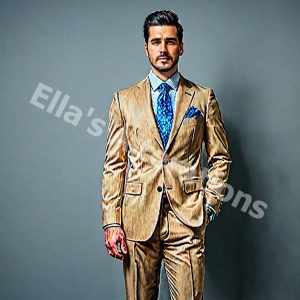
FAQs:
What exactly does a tailor do that a seamstress cannot when it comes to suits?
A tailor is the go-to pro when it comes to making and tweaking suits to perfection, from how they fit to how they look.
Unlike seamstresses, who tackle all sorts of sewing jobs on different clothes, tailors specialize in crafting men’s suits.
It’s a whole different ballgame, needing its own set of skills and know-how.
Tailors really get how a suit should hug a guy’s body just right.
They’re trained to make tiny tweaks that totally change how a suit hangs, like slimming down the waist or adjusting the shoulders to match the client’s shape.
And trust me, even small changes can make a big difference in how a suit turns out.
Plus, tailors are all about using the right materials, like wool and silk, that suit making calls for.
These fabrics need special treatment to make sure the suit lasts and feels comfy.
What’s more, tailors can do bespoke work, meaning they can whip up a suit from scratch based on the customer’s measurements and wishes.
They’ll help pick out the fabric, lining, buttons, and even decide on the suit’s style.
And the best part?
The client’s right there every step of the way, making sure the final suit is exactly what they want.
On the flip side, a seamstress might not have the tools or training needed for these super detailed requests, especially when it comes to the tricky structure of suits.
Sure, seamstresses are ace at alterations and fixes, but their gig leans more toward everyday clothes and simple tweaks.
Why are tailored suits considered a better investment compared to off-the-rack options?
Tailored suits are a smart move for a bunch of reasons: they fit better, last longer, let you put your own spin on things, and stay stylish for ages.
First off, a tailored suit is like a second skin—it’s custom-made to fit every curve and contour of your body just right.
Unlike those off-the-rack jobs that come in standard sizes, a tailored suit is tweaked to fit your unique shape and size, which means it not only looks better but feels comfier too.
And let’s talk construction.
Tailored suits are all about using top-notch materials and techniques.
Tailors stick to old-school methods that make the suit super sturdy. Take, for example, the full canvas construction they often use.
Instead of just gluing things together like in cheaper suits, they stitch in a layer of material between the fabric layers to give the jacket some structure and let it hang smooth.
Yeah, it takes more time and cash, but it’s worth it when your suit keeps its shape and stays looking sharp for years.
Then there’s the fun part: personalization.
When you go for a tailored suit, you call the shots.
You get to pick the fabric, the cut, the lapel style, the pocket design, and even the nitty-gritty stuff like the stitching and buttons.
It’s your chance to show off your style in every stitch.
Last but not least, tailored suits are timeless.
Because they’re built to such high standards and from top-quality materials, they tend to stay in fashion longer than those mass-produced suits.
And because they fit so darn well, they still look good even as trends come and go.
How long does it typically take to have a bespoke custom suit made?
Crafting a bespoke suit is a journey that can take anywhere from 4 to 12 weeks, depending on the tailor and the suit’s unique needs.
It all kicks off with a sit-down chat between the tailor and the client, where they hash out what the client wants and needs.
Then comes the fun part: picking out the materials and designing the suit.
Once those decisions are nailed down, the tailor gets to work taking precise measurements and putting together a rough draft of the suit, called a basted fitting.
This is like a first draft that’s stitched together loosely so the tailor can tweak things to fit just right.
After that fitting, the suit gets fine-tuned based on the client’s feedback and any new measurements taken.
There might be a few more fittings along the way to make sure every little detail is spot on.
Think adjusting sleeve length, tweaking trouser drape, and perfecting jacket shape.
Finally, it’s time for those finishing touches.
The last adjustments are made, and the suit gets its final polish and press.
It’s a super careful process that guarantees a suit that fits like a dream and checks off all the client’s boxes.
What should I look for when choosing a tailor for my suit?
Finding the right tailor is key to getting a suit that’s just right for you, both in style and fit.
Here are some things to think about when you’re on the hunt:
Experience and Expertise:
Look for a tailor who’s a pro at making men’s suits specifically.
Someone with lots of experience is more likely to give you the top-notch quality you’re after.
Portfolio and Past Projects:
A good tailor should have examples of their past work handy, whether it’s photos or actual suits you can check out.
Taking a peek at what they’ve done before can give you a feel for their style and skills.
Reviews and Recommendations:
Take a look at what other folks have to say online, and don’t be shy about asking friends or coworkers for recommendations.
Hearing about real experiences can be super helpful.
Fabric Choices:
A top-notch tailor will have a bunch of different fabrics for you to pick from, and they should all be top quality.
The fabric you choose can really make or break how your suit looks and lasts.
Personal Connection:
You’ll be working closely with your tailor, so it’s important that you click.
They should be cool with listening to what you want and offering up advice.
Good communication is key to making sure your suit turns out just right.
Price and Clarity:
Make sure you’re clear on how much things will cost and what’s included.
Bespoke suits can be pricey, but you should know what you’re getting into from the get-go so there are no surprises later on.
Can tailors adjust any suit, or are there limitations?
While tailors work wonders with suit adjustments, there are some limits to what they can do, especially if the suit wasn’t originally built for big changes.
Size Changes:
Shrinking a suit is usually easier than making it bigger.
There’s usually some extra fabric in the seams to work with, but expanding it depends on how much wiggle room there is.
Big Changes:
Messing with major stuff, like shoulder width, can be tough.
It takes a lot of work and might mess with how the suit’s supposed to look.
Tricky Fabrics:
Some fabrics, like silk or linen, are finicky to mess with.
They can show marks or damage if you mess around with them too much.
Style Switch-ups:
Turning a single-breasted jacket into a double-breasted one?
It might not be doable because of how the suit’s put together.
A pro tailor can steer you in the right direction, letting you know what’s doable and what might mess with how the suit looks or holds up.
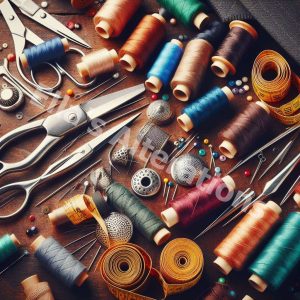
How to Get the Perfect Fit for Your Suit: A Guide to Suit Alterations.

About Us
|
Locations: 28.23362,
-82.181195, 25 Miles Location:
28.23362, -82.181195, 25 Miles Location:
28.23362, -82.181195, 25 Miles Location:
28.23362, -82.181195, 25 Miles Location:
28.23362, -82.181195, 25 Miles Location:
28.23362, -82.181195, 25 Miles Location:
28.23362, -82.181195, 25 Miles Location:
28.23362, -82.181195, 25 Miles Location:
28.23362, -82.181195, 25 Miles |
Exploring the meticulous craft of suit tailoring, “Fit for a King: Why Tailors, Not Seamstresses, Are Essential for Suits!” delves into why expert tailoring is indispensable for achieving the perfect men’s suit. The article discusses the tailor’s ability to enhance suit aesthetics, fit, and comfort, transforming an ordinary ensemble into a masterpiece of personal expression. It covers key topics like the bespoke process, the significance of Savile Row tailoring traditions, and the tailor’s role in customizing suits that adhere to both contemporary trends and timeless elegance.
